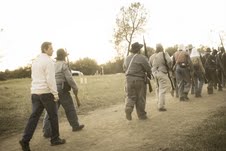By Maddy, Brayden, Gracie & Alex
On Saturday we went to Zion National Park outside of Saint George in southern Utah. We went with our family so we could learn about this area where Mormon settlers came in the 1860s. After having been to amazing places like Yosemite and Yellowstone we did not know how this park would compare.
After entering the park, we jumped on to a shuttle that took us on a scenic route through the valley floor. We saw huge mountains, cliffs and formations created by erosion, uplift, wind, water, ice, and sedimentation.
 We stopped for a delicious lunch at the Zion Lodge. As we looked up at the beautiful rocks we felt like tiny people compared to them.
We stopped for a delicious lunch at the Zion Lodge. As we looked up at the beautiful rocks we felt like tiny people compared to them. 
The colors of the rocks were magnificent. There were red, orange, white, blue, green and brown rocks. You could see the different layers of rocks like the sand in our collection jar at home.
 As the day wore on, the sun fell behind the rocks slightly and made the sides of the cliffs glow. In the glow of the light we could see rock climbers 3/4 of the way up. Seems pretty crazy to climb that size of a mountain!
As the day wore on, the sun fell behind the rocks slightly and made the sides of the cliffs glow. In the glow of the light we could see rock climbers 3/4 of the way up. Seems pretty crazy to climb that size of a mountain!  When we went on a hike along the Virgin River up toward the Narrows and we saw this funny looking feature in the rock. It looked like a big drippy nose. When rain falls it collect in the sandstone it finds its way through crevices and seeps out down below. Here it seems to drip out the nose.
When we went on a hike along the Virgin River up toward the Narrows and we saw this funny looking feature in the rock. It looked like a big drippy nose. When rain falls it collect in the sandstone it finds its way through crevices and seeps out down below. Here it seems to drip out the nose.

 The Virgin River can increase its level dramatically during a flash flood. When this happens it can move giant boulders, knock down tress, create flooding in nearby towns and change the landscape. The color of the water ranged from muddy to a sandy turquoise color.
The Virgin River can increase its level dramatically during a flash flood. When this happens it can move giant boulders, knock down tress, create flooding in nearby towns and change the landscape. The color of the water ranged from muddy to a sandy turquoise color.  When we came to the end of the trail some of us decided to cross the river and hike up the area called the Narrows. This area is called the Narrows because the area between the cliffs get very close together. The vegetation was very lush in this area and there were plenty of wildflowers. There were also a lot of fat squirrels that weren’t afraid of the people.
When we came to the end of the trail some of us decided to cross the river and hike up the area called the Narrows. This area is called the Narrows because the area between the cliffs get very close together. The vegetation was very lush in this area and there were plenty of wildflowers. There were also a lot of fat squirrels that weren’t afraid of the people.
 We had to wade through freezing cold water that made your feet numb. After a while you got use to it. It was fairly shallow, only about ankle deep to about knee deep.
We had to wade through freezing cold water that made your feet numb. After a while you got use to it. It was fairly shallow, only about ankle deep to about knee deep. Some areas had dry patches along the sides and we would criss-cross back and forth from one to the other.
Some areas had dry patches along the sides and we would criss-cross back and forth from one to the other.  This is the point where we decided to turn back. You can see that there is a small but beautiful waterfall on the rocks.
This is the point where we decided to turn back. You can see that there is a small but beautiful waterfall on the rocks.  After a day full of appreciating and exploring this national park we all agreed that this park was just as beautiful as Yosemite and Yellowstone. The huge cliffs, beautiful colors and the reflective sun shining through the trees and on the faces of the cliffs made it magnificent. We would recommend a visit to Zion in the fall like we did:)
After a day full of appreciating and exploring this national park we all agreed that this park was just as beautiful as Yosemite and Yellowstone. The huge cliffs, beautiful colors and the reflective sun shining through the trees and on the faces of the cliffs made it magnificent. We would recommend a visit to Zion in the fall like we did:)



































































































































